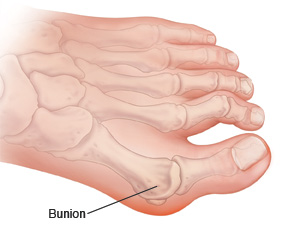You have a bunion. This is a bony bump at the base of your big toe, along the inside edge of your foot. As the bump gets bigger, it can become red, swollen, and painful with shoe wear.
Bunions may occur if you wear shoes that are too tight and pinch your toes together. High heels may make this worse. In some cases, a bunion is due to poor alignment of the foot and ankle. This puts extra weight on the instep of each foot.
Once a bunion forms, it changes the way weight is spread all across your foot. This causes the bunion to get worse over time. The big toe will bend more and more toward the other toes.
A minor bunion can be treated by:
-
Wearing correctly fitting shoes.
-
Using bunion pads or a toe spacer.
-
Wearing shoe inserts, called orthotics, to better align the foot and ankle.
Physical therapy with ultrasound or whirlpool baths can ease pain, redness, and swelling. Severe cases may need surgery. If you don’t treat what is causing the bunion, it may get larger and more painful.
Home care
-
Don't wear high heels. These shoes force your foot forward, crowding the toes together.
-
Wear comfortable shoes with a wide toe area. Or have your existing shoes stretched by a shoe repair shop.
-
Don't wear shoes that are tight, narrow, or pointed.
-
If you are flat-footed, using arch supports may help prevent further deformity. The best shoe inserts are the ones custom made by an orthotic professional, an orthotist, or other health care provider.
-
Put a bunion pad over the bunion to ease pressure of your shoe against the bunion. You can buy these pads at most pharmacies without a prescription.
-
To reduce pain and swelling, apply an ice pack over the injured area for 15 to 20 minutes. Do this every 1 to 2 hours the first day. Keep using ice 3 to 4 times a day until the pain and swelling goes away.
-
To make an ice pack, put ice cubes in a sealed zip-lock plastic bag. Wrap the bag in a clean, thin towel or cloth. Never put ice or an ice pack directly on the skin. Check your skin often for sensation while using cold therapy. This will help make sure you aren't damaging the tissues.
-
You may use over-the-counter pain medicine to control pain, unless another medicine was prescribed. Talk with your provider before using these medicines if you have chronic liver or kidney disease, you ever had a stomach ulcer or gastrointestinal bleeding, or you use a blood thinner.
Follow-up care
Follow up with a health care provider as advised.
If X-rays were taken, you will be notified of any new findings that may affect your care.
When to get medical care
Contact your provider if you have:
-
Increasing pain or redness around the base of the big toe.
-
A painful ingrown toenail, with redness and swelling or pus around the nail.


